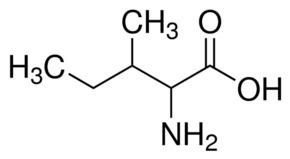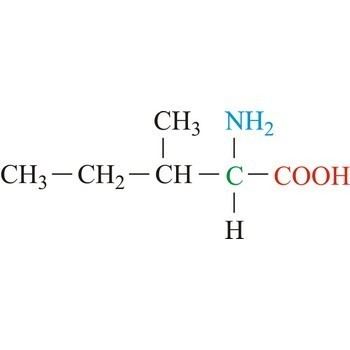Formula C6H13NO2 | Molar mass 131.1729 g/mol | |
 | ||
Thermodynamicdata Phase behavioursolid–liquid–gas | ||
Bcaa muscle growth with leucine valine and isoleucine
Isoleucine (abbreviated as Ile or I) encoded by the codons ATT, ATC, ATA is an α-amino acid that is used in the biosynthesis of proteins. It contains an α-amino group (which is in the protonated −NH+
3 form under biological conditions), an α-carboxylic acid group (which is in the deprotonated −COO− form under biological conditions), and a hydrocarbon side chain, classifying it as a non-polar, uncharged(at physiological pH), aliphatic amino acid. It is essential in humans, meaning the body cannot synthesize it, and must be ingested in our diet. Isoleucine is synthesized from pyruvate employing leucine biosynthesis enzymes in other organisms such as bacteria.
Contents
- Bcaa muscle growth with leucine valine and isoleucine
- Isoleucine ile threonine thr essential amino acids 27sep10
- Biosynthesis
- Catabolism
- Synthesis
- References

Inability to break down isoleucine, along with other amino acids, is associated with the disease called Maple Syrup Urine Disease, which results in discoloration and a sweet smell in the patient's urine, which is where the name comes from. However, in severe cases, MSUD can lead to damage to the brain cells and ultimately death.

Isoleucine ile threonine thr essential amino acids 27sep10
Biosynthesis

As an essential nutrient, it is not synthesized in the body, hence it must be ingested, usually as a component of proteins. In plants and microorganisms, it is synthesized via several steps, starting from pyruvic acid and alpha-ketoglutarate. Enzymes involved in this biosynthesis include:
- Acetolactate synthase (also known as acetohydroxy acid synthase)
- Acetohydroxy acid isomeroreductase
- Dihydroxyacid dehydratase
- Valine aminotransferase
Catabolism

Isoleucine is both a glucogenic and a ketogenic amino acid. After transamination with alpha-ketoglutarate the carbon skeleton can be converted into either Succinyl CoA, and fed into the TCA cycle for oxidation or converted into oxaloacetate for gluconeogenesis (hence glucogenic). It can also be converted into Acetyl CoA and fed into the TCA cycle by condensing with oxaloacetate to form citrate. In mammals Acetyl CoA cannot be converted back to carbohydrate but can be used in the synthesis of ketone bodies or fatty acids, hence ketogenic.

Biotin, sometimes referred to as Vitamin B7 or Vitamin H, is an absolute requirement for the full catabolism of isoleucine (as well as leucine). Without adequate biotin, the human body will be unable to fully break down isoleucine and leucine molecules.
Synthesis

Isoleucine can be synthesized in a multistep procedure starting from 2-bromobutane and diethylmalonate. Synthetic isoleucine was originally reported in 1905.
German chemist Felix Ehrlich discovered isoleucine in hemoglobin in 1903.
